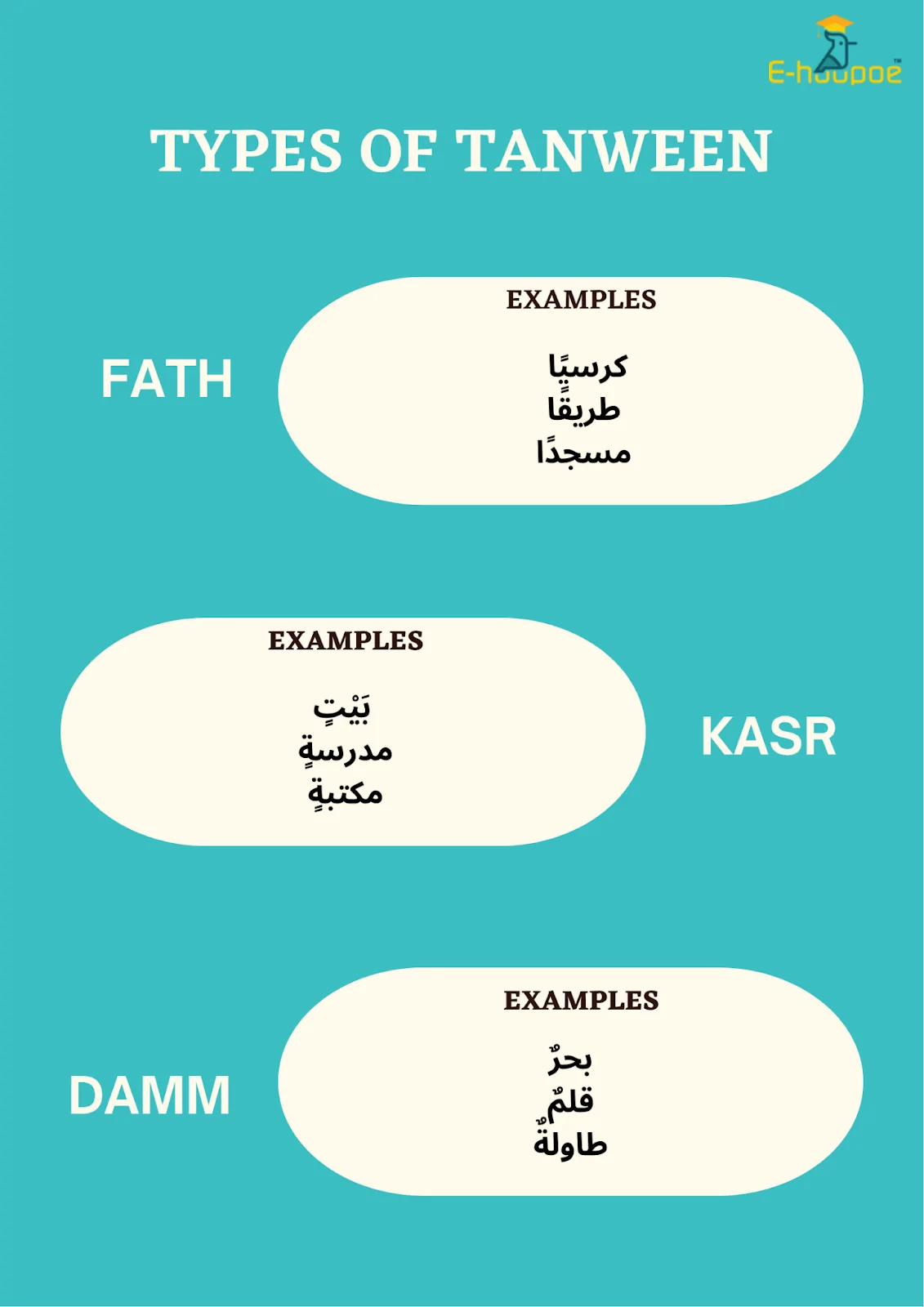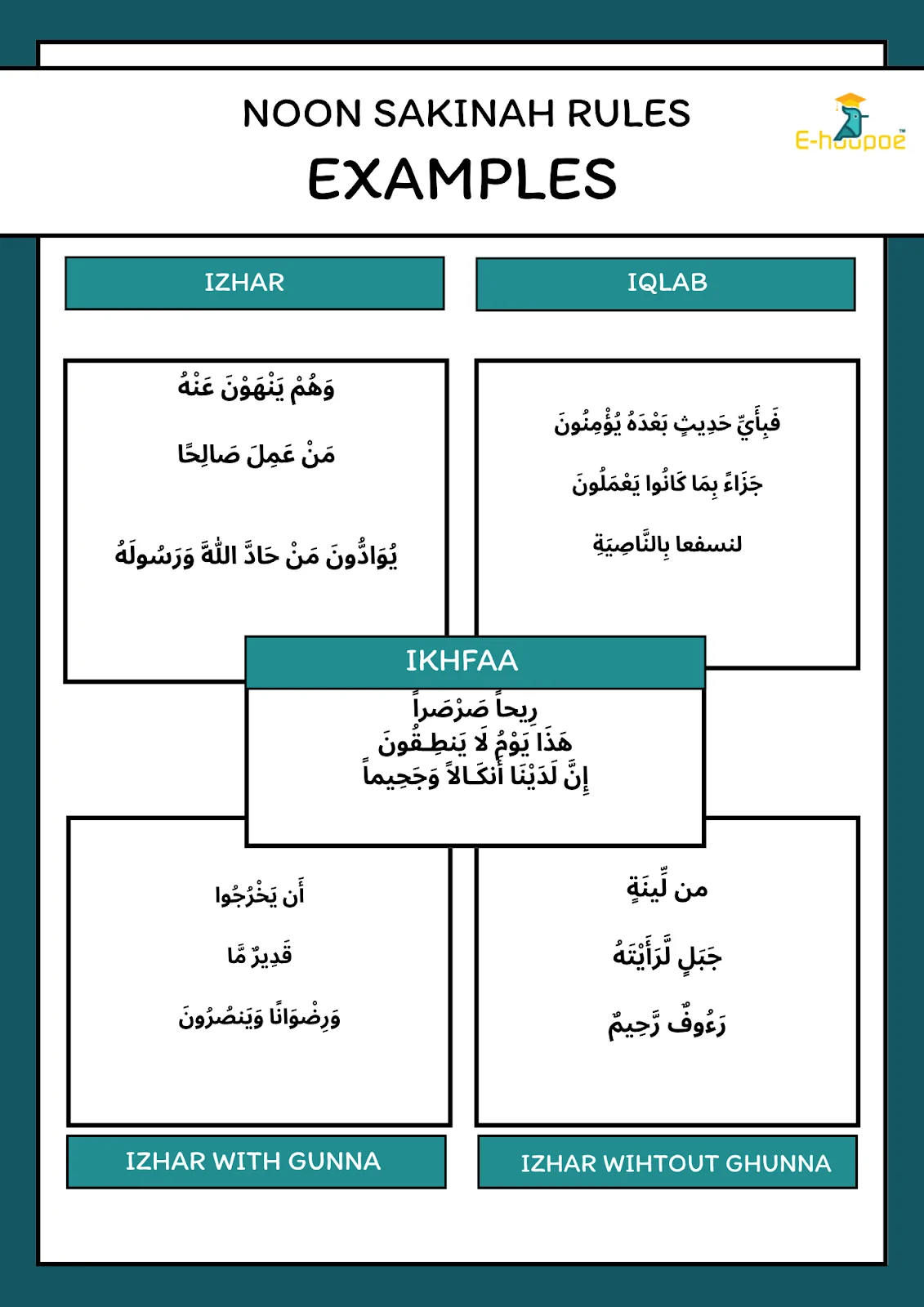Noon Saakin and Tanween are among the most vital topics in the study of Tajweed. Tanween, a key feature of Arabic grammar and pronunciation, plays a crucial role in shaping and understanding words within both everyday Arabic and the Quranic text. Meanwhile, the noon saakin rules in Tajweed govern the correct pronunciation of the letter “Noon Sakin” during Quran recitation.
To truly grasp the meanings and beauty of the Holy Quran, a clear understanding of Noon Saakin and Tanween is essential. Mastering these rules not only enhances the accuracy of your recitation but also deepens your connection to the divine words, allowing the verses to come alive with clarity and reverence.
What is Noon Sakinah?
Noon Saakinah (نْ) is the letter Noon (ن) with a SuKoon (a diacritical mark ( ْ ) that indicates the absence of any vowel. This means the Noon remains silent or static and does not carry a Fatha, Dammah, or Kasrah.
Noon Saakinah can appear either in the middle or at the end of a word. Its pronunciation is influenced by the letter that comes immediately after it, which is why understanding the Noon Saakinah rules is crucial in Tajweed (the art of Quranic recitation).
Reading the Quran following the correct rules for Noon Saakinah is key to keeping the text clear, rhythmic, and accurate.
Explaining tanween in tajweed
Tanween, also known as nunation, is a grammatical and phonetic feature in Arabic where a short vowel sound is followed by an “n” sound . Even though it doesn’t look like a regular Noon (ن) on paper, at the end of a word, it sounds just like a Noon Saakinah (نْ).
Tanween appears in three forms:
- Fathatan (ــً)
- Kasratan (ــٍ)
- Dammatan (ــٌ)
Each of these is written using two diacritic marks placed either above or below the final letter.

Tanween typically occurs at the end of indefinite nouns or adjectives and it helps identify grammatical case endings in Arabic. In Tajweed, it is essential because although Tanween looks different from Noon Saakinah, it is recited the same way by adding a hidden “ن” sound.
The main differences between noon saakinah & tanween
| Aspect | Noon Saakinah (نْ) | Tanween (ــً / ــٍ / ــٌ) |
| Nature | A fixed letter in the Arabic alphabet | A diacritical mark added to indicate an /n/ sound |
| Appearance in Text | Clearly written and pronounced | Heard when reciting, but not written as a separate letter |
| Position in Word | Can appear in the middle or at the end of words | It only shows up after indefinite nouns. |
| Grammatical Use | Found in nouns, verbs, and particles | Found only in nouns |
| Pronunciation Rules (Waqf/Wasl) | Pronounced in both continuation (wasl) and pause (waqf) | Pronounced only in continuation (wasl); dropped in pause (waqf) |
The four guiding rules of Noon Saakinah and Tanween
When reciting the Qur’an with proper Tajweed, there are four key rules that govern how we pronounce Noon Saakinah (نْ) and Tanween (ــً / ــٍ / ــٌ). These guidelines explain when to articulate the sound distinctly, suppress it, blend it, or modify it.
- Izhar
- Iqlab
- Idgham
- Ikhfaa
Tanween and noon saakin rules:
- Izhar:Izhar occurs when one of the six throat letters comes after a Noon Saakin or Tanween. These letters are: — ء، هـ، ع، ح، غ، خ —. In this rule, the Noon or Tanween is pronounced clearly and distinctly from the following letter, without merging or nasalization, ensuring that its articulation point is maintained.
- Iqlab: when Tanween or Noon Saakin come before ب (ba). In this case, the Noon or Tanween sound is converted into a hidden Meem (م) sound, accompanied by a nasal tone (ghunna) for two counts. This rule essentially replaces the Noon with a Meem in pronunciation to facilitate smooth and correct recitation.
- Idghaam: Idgham is the merging of the Noon Saakin or Tanween into the following letter when it is one of the six letters: ي، ن، م، و، ل، ر, can be gathered in word (يرملون.
There are 2 types of idgham:
- Idgham with ghunna happens whenever a Noon Saakin or Tanween is followed by any of the letters ي، ن، م، or و. In this case, the Noon or Tanween is merged into the following letter with a nasal sound (ghunna) that is held for two counts, blending the two letters smoothly.
- Idgham without ghunna should be apploed when the letters ل, ر come after a Noon Saakin or Tanween. Here, the Noon or Tanween is merged directly into the following letter without any nasalization. The shift happens fast and seamlessly, with the Noon or Tanween not being pronounced separately.
- Ikhfaa: Ikhfaa occurs when any of the fifteen other letters come after a Noon Saakin or Tanween. The Noon or Tanween is not pronounced clearly nor fully merged but is instead partially hidden, producing a softened nasal sound that sits between clarity and merging.
Noon saakinah and tanween rules in English
The rules of Noon Saakinah and Tanween in English are described through four key terms that reflect how the Noon or Tanween is treated during recitation:
- Izhar translates to “making something obvious.” Under this guideline, the Noon or Tanween is articulated distinctly, without any blending or hiding.
- Idghaam is “merging together” This is used to describe joining the Noon or Tanween with the following letter, with or without nasalization.
- Iqlab is the “conversion”. Iqlab is the tajweed rule that changes the Noon or Tanween sound into a Meem sound with a nasal sound in the presence of a certain letter.
- Ikhfaa means “concealment” or “to hide.” The Noon or Tanween is partially hidden, producing a light nasal sound without full clarity or full merging.
Examples for noon saakin rules

Common mistakes to avoid with noon saakinah & tanween
- Applying the Wrong Rule: Mistaking one rule for another like using Ikhfaa instead of Izhar. To prevent this, memorize the specific letters for each rule and use a Tajweed chart when you practice as a quick reference guide.
- Weak Ghunnah Pronunciation: Numerous students do not extend the nasal sound properly in Idghaam with Ghunna and in Ikhfaa when practicing. Practice holding the Ghunnah for two counts, listen to expert reciters, and record your own recitation to identify weak spots.
- Over- or Under Emphasizing Letters: Overdoing the blending in Ikhfaa or skipping the nasalization can disrupt clarity. Work with a teacher to refine balance and develop sensitivity to subtle transitions.
- Mixing up between Tanween with Noon Saakin: Tanween and Noon Saakin are often confused. Tanween is considered a grammatical symbol, not a letter. Recognize that Tanween always appears at the end of indefinite nouns and sounds like a final Noon, though it’s not written as one.
- Skipping Rules Altogether: Ignoring the Tajweed rules leads to incorrect pronunciation. Take time to study each rule and understand its purpose, then apply them consciously during recitation.
- Incorrect Letter Articulation (Makharij): Especially throat letters for Izhar due to poor articulation is common. Learn the correct Makharij for letters, and utilize apps or seek help from someone reputable to receive feedback.
Useful tips to apply noon saakin rules effectively
- Listen to Experts: Immerse yourself in the recitations of skilled Qaris (reciters) to hear how each rule is properly applied in real-time. This improves your pronunciation and strengthens your audio memory.
- Seek Guidance: Join a structured Tajweed course, such as the one offered by E-hoopoe, where experienced teachers guide you through each rule.
- Repetition is Key: Practice each rule across different Quranic verses until the sound and rule become second nature. Repetition builds fluency and confidence.
- Use Tajweed Tools: Take advantage of Tajweed books, apps, and rule charts to reinforce your learning. Visual tools make it easier to remember specific letters and rule triggers.
- Record Yourself: Listening to your own recitation can be eye-opening. Record and review to pinpoint errors, this makes your progress visible and helps with self-correction.
Master the art of tajweed with E-hoopoe
E-hoopoe is a comprehensive online platform dedicated to strengthening your connection with the Quran and advancing your recitation skills. Our best online Tajweed course is designed for learners at all levels, offering a thoughtfully structured curriculum that provides a deep understanding of Tajweed rules and practical guidance on how to apply them with clarity and confidence. This course goes beyond theory; it’s an immersive journey that refines your pronunciation, rhythm, and fluency in Quranic recitation. With expert instructors who combine years of teaching experience with a genuine passion for the Quran, you’ll receive personalized support and motivation every step of the way.
Conclusion
Tanween and noon saakin rules are essential components of Tajweed that must be fully understood to ensure accurate and beautiful Quranic recitation. Not applying these rules correctly can completely change the flow of the recitation. By mastering these principles, learners not only improve their pronunciation and fluency but also deepen their spiritual connection with the Quran.
At E-hoopoe, learning Tajweed is more than a course; it’s a transformative experience. Our online Tajweed course is designed to help you internalize the beauty of Quranic recitation, guiding you from basic understanding to confident mastery.
Book your free trial now and become one of the many students who transformed their Quranic recitation with us.
Frequently asked questions
- What is the difference between idgham with ghunna and idgham without ghunna?
Idgham with ghunna involves merging with a nasal sound (ghunna), while idgham without ghunna merges without the nasal sound.










